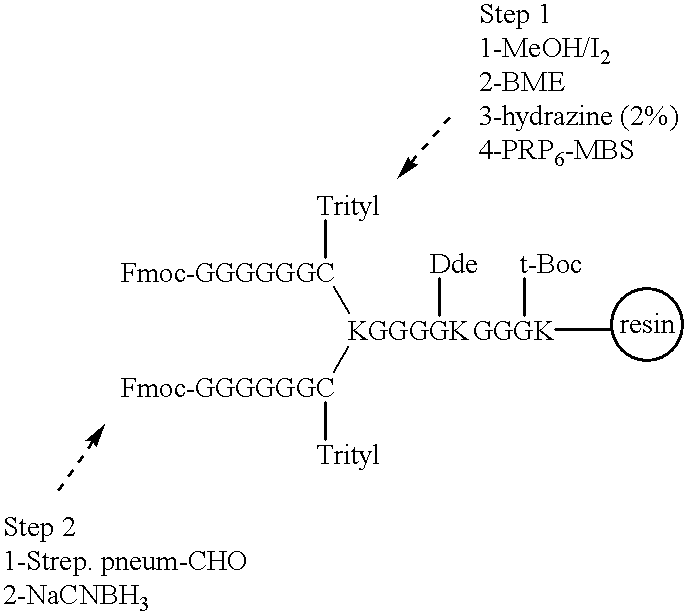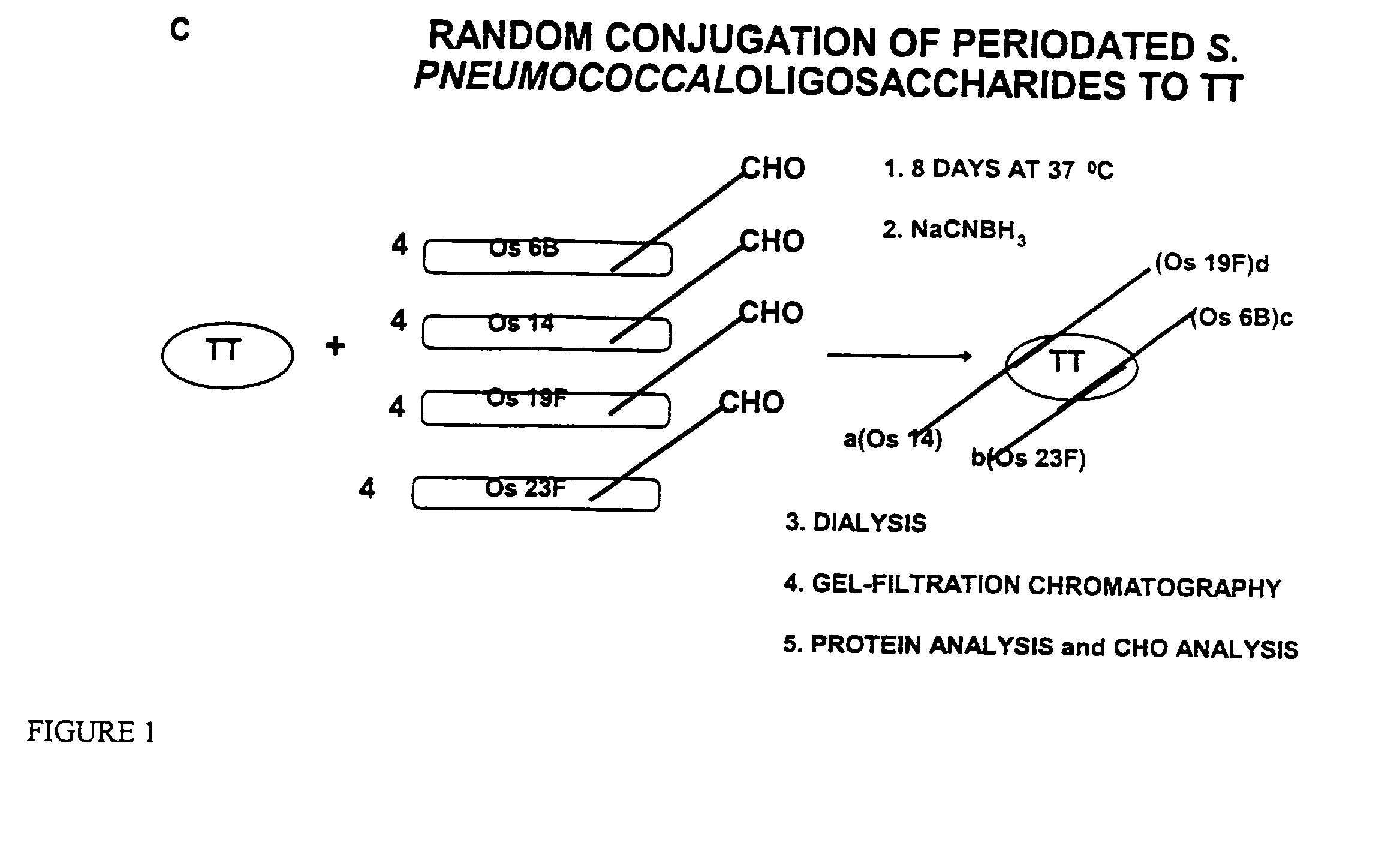Novel multi-oligosaccharide glycoconjugate bacterial meningitis vaccines
a technology of oligosaccharide and vaccine, applied in the direction of snake antigen ingredients, bacterial antigen ingredients, non-active ingredients, etc., can solve the problems of short-lived antibody response and limited by the number of responsive b-cells, and achieve the effect of stimulating a long-lasting immune respons
- Summary
- Abstract
- Description
- Claims
- Application Information
AI Technical Summary
Benefits of technology
Problems solved by technology
Method used
Image
Examples
example 1
[0119] Preparation of acid-hydrolyzed group B meningococcal (GBM) oligosaccharides.
[0120] This Example describes a method for preparing GBM oligosccharides (M. wt. 3000 to 4500 Da) from the commercially available GBM polysaccharides (M. wt>10 KDa).
[0121] Reagents required:
[0122] 1-GBM polysaccharides from Sigma cat # C-5762.
[0123] 2-Sodium acetate (50 mM) buffer pH 5.00, prepared by mixing one volume of 0.5M sodium acetate with one volume of 0.23M acetic acid.
[0124] 3-Reaction vial and a magnetic stirring bar.
[0125] 4-Sephadex G-25 gel column
[0126] 5-Ammonium bicarbonate (20 mM)
[0127] Procedure:
[0128] The GBM polysaccharide (200 mg) was dissolved in 15 mL of degassed 50 mM sodium acetate buffer, pH 5.0 and the mixture was then stirred at 80.degree. C. for 1 hr. The reaction mixture was then immediately cooled with ice and neutralized to pH 7.0 by dropwise addition of 0.1M NaOH. The total mixture was then lyophilized to yield a crude product (460 mg, containing sodium acetate) About ...
example 2
[0134] This Example shows chemical modification of acid-hydrolyzed GBM oligosaccharides.
[0135] N-propionylated, acid-hydrolyzed GBM oligosaccharides were prepared according to the method previously described by H. Jennings et al. (ref. 6) with some modifications. The N-propionylated GBM oligosaccharides ultimately were coupled to a MAP backbone containing other oligosaccharide to produce multivalent multiple carbohydrate vaccines, as described below.
[0136] Reagents required:
[0137] 1-Acid-hydrolyzed GBM oligosaccharides.
[0138] 2-Sodium hydroxide (2M solution).
[0139] 3-Propionic anhydride (Aldrich).
[0140] 4-Ammonium bicarbonate (10 mM)
[0141] 5-Aqueous oxalic acid (50%)
[0142] 6-Sodium borohydride (Sigma)
[0143] Procedure:
[0144] N-deacetylation of the acid-hydrolyzed GBM oligosaccharides:
[0145] N-deacetylated acid-hydrolyzed group B meningococcal polysaccharides was prepared according to the method described by Jenning et al., with three modifications;
[0146] 1-The reaction was performed ...
example 3
[0152] This Example shows the preparation of Oligosaccharides from Streptococcus Pneumoniae
[0153] This Example describes the general methods using acid hydrolysis of Streptococcus pneumoniae capsular polysaccharides (CP) (M. wt.about.50 kDa) to produce oligosaccharides with a molecular mass ranging from 2.5 to 5.0 kDa. The resulting oligosaccharides can be subjected to a novel glycoconjugation technology to prepare glycoconjugates containing multiple-oligosaccharides covalently linked to a carrier protein or a multiple antigen peptide system (MAP).
[0154] Reagents required:
[0155] 1-CP serotypes 6B, 14, 19F and 23F (ATTC)
[0156] 2-Acetic acid
[0157] 3-Trifloroacetic acid
[0158] 4-Gel chromatography column (Sephadex G-100, 10.times.1000 mm)
[0159] 5-Round bottom flask (250 mL)
[0160] 6-Magnetic stirring bar
[0161] 7-Oil bath
[0162] Procedure:
[0163] In a round bottom flask, the CPs (see Table below) was dissolved in warm degassed water (62.5 mL) followed by the addition of the required amount ...
PUM
| Property | Measurement | Unit |
|---|---|---|
| molecular weights | aaaaa | aaaaa |
| molecular weights | aaaaa | aaaaa |
| mean mass | aaaaa | aaaaa |
Abstract
Description
Claims
Application Information
 Login to View More
Login to View More - R&D
- Intellectual Property
- Life Sciences
- Materials
- Tech Scout
- Unparalleled Data Quality
- Higher Quality Content
- 60% Fewer Hallucinations
Browse by: Latest US Patents, China's latest patents, Technical Efficacy Thesaurus, Application Domain, Technology Topic, Popular Technical Reports.
© 2025 PatSnap. All rights reserved.Legal|Privacy policy|Modern Slavery Act Transparency Statement|Sitemap|About US| Contact US: help@patsnap.com



